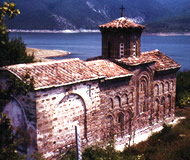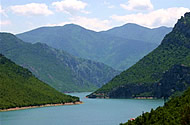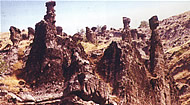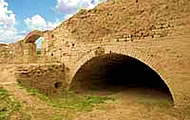 |
  St. George at Polosko Monastery St. George at Polosko Monastery
The monastery of St. George is located on the shores of the man-made Lake Tikves, and the only way to get there is by boat. Its fresco paintings are completely preserved and, according to the historical portraits on the west facade, can be dated back to around 1343-45. In the early 17th century the church obtained a narthex and in the 19th century it was restored for the last time. The monastery is well known for its inventory, icons, wood carved chorus of 1492, and iconostasis cross of 1584.
Tikves Strict Natural Reserve
It is located 30km southeast of Kavadarci, encompassing an area of about 10,000 hectares. Some 23 species of predatory birds are present in the reserve, 17 of which nest in this area. Tikves Strict Natural Reserve is one of the most important ornithological sites in Europe.
  Lake Tikves Lake Tikves
The long, snaking Lake Tikves is Macedonia’s biggest manmade lake. It is located 12km southwest of the town of Kavadarci on the River Crna, or 3km from the village of Vozarci. The lake, which was built in 1968, is some 30 km long and traces its long and narrow course southwest from Mt. Kozjak, where the River Crna widens to create it. The whole area of Lake Tikves is particularly rich in fauna. The lake is simply bursting with fish; the most remarkable is the sheatfish, a legendary type of catfish that can reach up to 2 meters in length.
  Konopiste Konopiste
Konopiste village near Kavadarci hosts a very interesting geomorphologic structure, a natural phenomenon. The structure is inside a short dry dale on the right bank of the Bosava River, at 740m above the sea level.
  Isar, Marvinci Isar, Marvinci
According to historical records, the remains of a settlement found at this archeological site date from the early ancient period. An unearthed “stadium’ – milestone found at this site, which dates from the 3rd or the beginning of the 2nd century B.C., might mean that the name of the city was Dober or Idomene. The archeological finds date from the Bronze Age to Late Ancient Age, and shed more light on the culture of Payonia in pre- Roman times. This archeological site contains remnants of a temple, dated 181 B.C. and is designed according to the Roman blueprint of a temple building. It is dedicated to Roman Emperor Comod.
back |
|
|
|
|
|
|